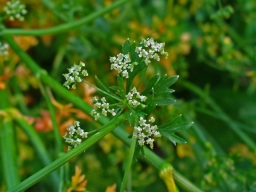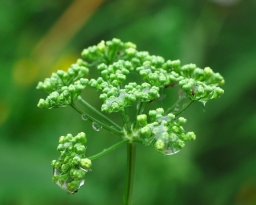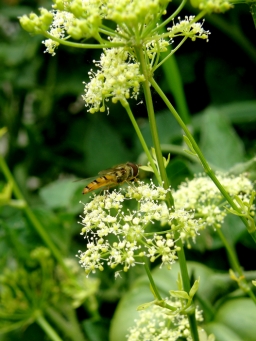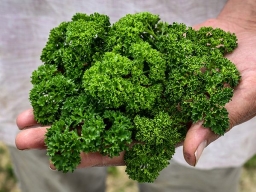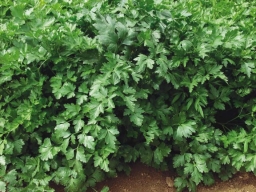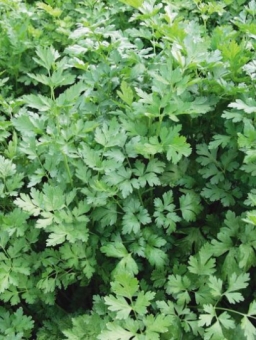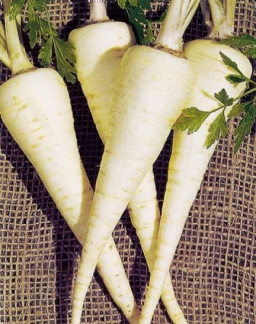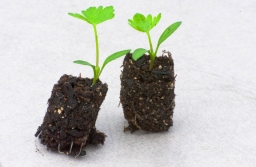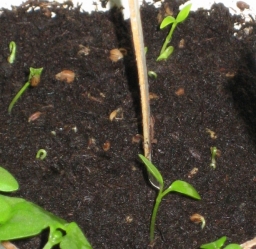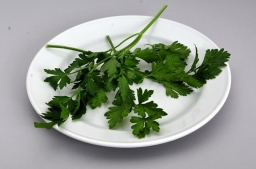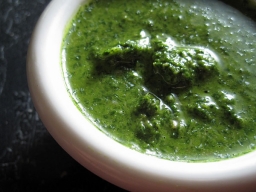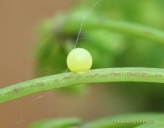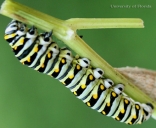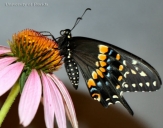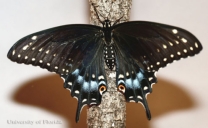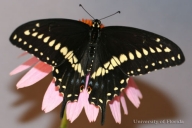| Parsley, Petroselinum crispum | |||||||||||||||||||||||||||||||||||||||||||||
|---|---|---|---|---|---|---|---|---|---|---|---|---|---|---|---|---|---|---|---|---|---|---|---|---|---|---|---|---|---|---|---|---|---|---|---|---|---|---|---|---|---|---|---|---|---|
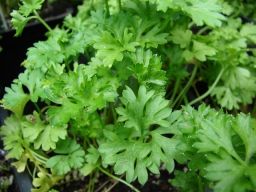 Fig. 1  Petroselinum crispum leaves 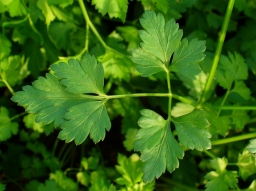 Fig. 2  P. crispum 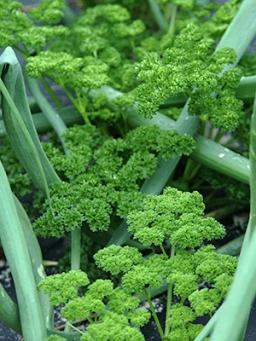 Fig. 3  Fig. 4  'Moss Curled' parsley (extra-ruffled) 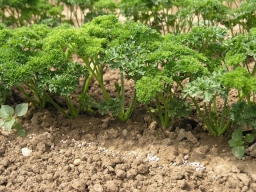 Fig. 5  P. crispum 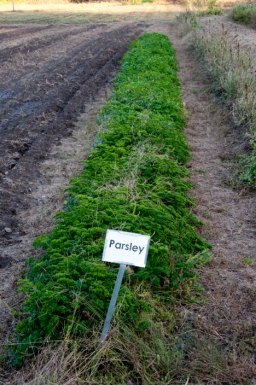 Fig. 6  Small farm 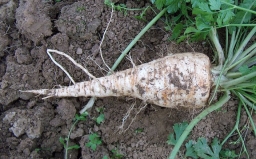 Fig. 19  P. crispum var. tuberosum 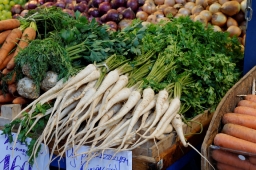 Fig. 20  P. crispum var. tuberosum, le persil tubéreux. Halles centrales de Budapest. 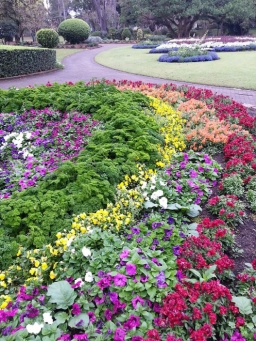 Fig. 24  Rainbow garden, Brisbane City Botanic Gardens, mainly petunias and parsley  Fig. 25  Curly leaf parsley in a flower-bed  Fig. 26  Parsley salad Restaurant Persepolis, Beijing 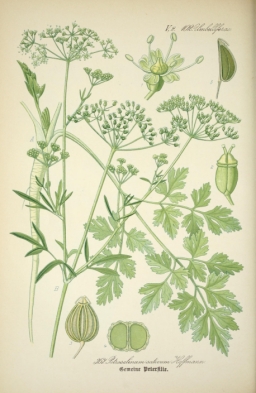 Fig. 29  P. sativum Hoffmann, 1888 Direktor Prof. Dr. Thom's Flora von Deutschland, O¨sterreich und der Schweiz 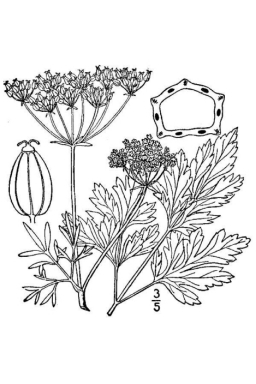 Fig. 30  Apium petroselinum L., 1913 An illustrated flora of the northern United States, Canada and the British Possessions.  Fig. 31  Español: Objeto de cerámica tipo Talavera para el perejil |
Scientific
name Petroselinum crispum (Mill.) Nym. Common names (crispum and neapolitanum groups) Arabic: بقدونسbaqdunis, مقدونس maqdunis; Bulgarian: магданоз magdanoz; Chinese: 欧芹 ou qin; Croatian: peršin; Czech: petržel; Danish: persille; English: common parsley; Finnish: persilja; French: persil commun; German: Blattpetersilie, Petersilie; Greek: μαϊντανό maïntano, μαϊντανός maïntanos, μακεδονίσι makedonisi, περσέμολο persemolo; Hebrew: פטרוזיליה petrosilia; Hungarian: petrezselyem; Italian: prezzemolo; Japanese: パセリ paseri; Korean: 파슬리 pa sul li; Khmer: vanns baraing; Polish: pietruszka zwyczajna; Portuguese: salsa; Russian: петрушка petrushka; Serbian: peršun; Slovenian: peteršilj ; Slovakian: petržlen záhradný; Spanish: perejil; Swedish: bladpersilja, persilja; Thai: ผักชีฝรั่ง phak chi farang; Turkish: maydanoz; Vietnamese: rau mùi tây 10 Synonyms Apium crispum Mill., A. petroselinum L., Carum petroselinum (L.) Benth. & Hook. f., P. hortense Hoffm., P. sativum Hoffm., P. vulgare Lagasca 4,10 Common names (tuberosum group) Hamburg parsley, Dutch parsley, turnip-rooted parsley 7 Relatives Angelica (Angelica archangelica), anise (Pimpinella anisum), asafoetida (Ferula foetida), caraway (Carum carvi), carrot (Daucus carota), celery (Apium graveolens), chervil (Anthriscus cerefolium), coriander (Coriandrum sativum), cumin (Cuminum cyminum), dill (Anethum graveolens), fennel (Foeniculum vulgare), lovage (Levisticum officinale), parsnip (Pastinaca sativa) 4 Family Apiaceae/Umbelliferae (carrot family) 4 Origin Southern Europe, eastern Mediterranean 7 USDA hardiness zones 5-11 7 Uses Culinary: flavoring; breath freshener; garden borders, containers; black swallowtail butterfly larvae host 1,2 Height 12-18 in. (30-45 cm) cultivar dependent Plant habit Clump-forming Life cycle Biennial (for seed); cool season annual 2 Leaves Broad, pinnate to 3-pinnate, aromatic; become coarser the second year 9 Flowers/seed Small yellow-green in umbels; bisexual (hermaphrodite); 0.08 in. (2 mm) floret 5,9 Inflorescence Atop a 3-6 ft (1-1.8 m) stem: five greenish-yellow petals, five stamens, two styles, a two-celled ovary, each cell of which produces one seed 5 Season Sept.-May 2 Days to maturity from seed 70-80 3 pH preference 6.5-7.5 6 Spacing Plants 2-3 in.; row: 1 ft. apart 2 Yield per 100 ft 30-40 pounds per row 6 USDA Nutrient Content fresh, freeze-dried pdf Light requirement Full or part sun; some afternoon shade 1,7 Water requirement Keep the soil well watered, parsley requires very moist soil 2 Flood tolerance Well drained Cold tolerance About 20 °F (-6.7 °C) 7 Temperature requirement 50-70 °F (10-21 °C) 7 Invasive potential * None reported Known hazard Relatives include deadly poisonious: poison-hemlock; water-hemlock; fool's-parsley 16 Reading Material Parsley—Petroselinum crispum, University of Florida pdf Parsley, University of Florida Parsley, University of California, Davis pdf Origin/Distribution Both the crowded, dense-leaved type and the broad open-growing type were described in the 4th century B.C. Parsley was introduced into England from Sardinia in 1548. European colonists brought parsley to the United States in the 17th century, and it continues to be a popular garden vegetable nationwide. 2 Parsley cultivated everywhere for its leaves, seeds and roots. 7 It is grown throughout Florida, both as a commercial crop of minor importance in the vegetable producing areas of central and south Florida, and in gardens from Key West to Pensacola. 2
Fig. 7. P. crispum 9,927 georeferenced records Description Parsley is a bright green, versatile herb that looks good growing and tastes good too. Parsley contains vitamins A, C, and K as well as several B vitamins, calcium, and iron. 1 The varieties neapolitanum (plain, flat, or Italian parsley) and crispum (common or curly-leaved) are grown for their leaves, while the lesser-known tuberosum ('Hamburg' or turnip-rooted) is grown for its enlarged, edible root as well as for the leaves. 14 During the first year, parsley forms a dense rosette of leaves. In the second year, it develops a 3- to 6-foot stem with small greenish-yellow flowers. 5 Flowers Parsley umbels are less dense than those of carrots. 5
Fig. 8. Botanical Garden KIT, Karlsruhe, Germany Fig. 9. Inflorescence Fig. 10. Unopened flower head of curly parsley Fig. 11. Syrphe hoverfly on P. crispum Varieties Each if the three varieties [grown in the USA], have several popular cultivars. • P. crispum var. crispum Typical curly leaf parsley, with many cultivars including some that look like moss. ‘Curled-leaf,’ a very finely divided leaf type used more as a garnish; cultivars include: 'Banquet', 'Forest Green', 'Improved Market Gardeners', 'Moss Curled'; hybrid: 'Jade'. • P. crispum var. neapolitanum includes the Italian or flat-leaf parsleys which have a slightly stronger flavor than the curly leaf types; less decorative and generally used more in cooking; cultivars include: 'Dark Green Italian', 'Giant of Italy', 'Plain Italian Green'. ‘Neapolitan’ (or celery leaf) is grown for its leaf stalks, which are eaten like celery. • P. crispum var. tuberosum includes the 'Hamburg', turnip-rooted and German parsley cultivars which are grown for their flavorful parsnip-like roots. They have a delicious nutty flavor, reminiscent of a combination of celery and parsley and the tops can be eaten too. 3,7
Fig. 12. 'Moss Curled'. Curled parsley has been grown for hundreds of years and was mentioned in the Otto Schwill and Co. seed catalog in 1896. Fig. 13. 'Triple Curled' parsley. Closely curled dark green leaves. 9-12 in. (23-30 cm) tall; fast growing uniform strain; holds for a long time at harvesting stage even in warm weather, 68-75 days. Fig. 15. 'Gigante D'Italian' (parsley/plain leaf). Extra large dark green, flat leaf, strong stems. Very aromatic, 80 days. Fig. 16. 'Laura' (parsley/plain leaf). Smooth, small flat leaf bunching type. Vigorous upright growth. Very dark glossy green color. Strong stems. Suitable for cutting and container cultivation. Tolerant to Black Spot, 78 days. Fig. 17. 'Arat.' Grow like carrots. Sweeter and more uniform than 'Hamburg', these roots are whoppers: they fill out well and grow almost a foot, benefiting from a deeply worked seed bed. You can sustain a harvest through much of the winter and possibly into spring if you protect them, 88 days. Fig. 18. 'Hamburg' half long (parsnip/rooted parsley type). Heavy shoulder, half long, wedge shaped roots resemble Chantenay carrots. A refined 'Berliner' type. Preferred North American shape. Roots average 6 in. (15 cm), 85 days. Harvesting The outer leaves can be removed for table use, and the plant continues producing. Cutting entire plants 1.25-3 in. (3.2-8 cm) above the crown may result in secondary growth sufficient to allow for another harvest. Maximum biomass usually occurs at 75-90 days after germination. 6 Rapid removal of field heat without excessive drying helps retain green color and freshness. Parsley can be precooled with ice (package icing or liquid-icing [Cantwell and Reid 1992]) or by vacuum-cooling (Aharoni et al. 1989). Forced-air cooling or hydrocooling are commonly practiced (Joyce et al. 1986). 13 Storage The recommended conditions for commercial storage of parsley are 0 °C (32 °F) with 95 to 100% RH [relative humidity]. Parsley can be stored for 1 to 2 months under these conditions, compared to only 3 days at 18-20 °C (64-68 °F) with 85-90% RH. The endpoint of storage at 0 °C (32 °F) occurs when parsley wilts, at around 20% weight loss. MAP [modified atmosphere packaging] is effective in extending storage life, but temperature changes and condensation must be avoided. Aharoni et al. (1989) showed that nonperforated polyethylene liners delayed yellowing and decay at low temperature. Park et al. (1999) achieved 77 days of storage at 0 °C (32 °F) and 35 days at 5 °C (41 °F) with good retention of firmness and vitamin C content by using a 40 µm-thick ceramic film. A preharvest spray with gibberellic acid may extend storage life (Lers et al. 1998). Hamburg parsley roots (without leaves) can be stored at 0 °C (32 °F) for several months. 13 Frozen parsley retains more flavor than dried. If you do dry parsley, the Italian varieties are better since they have a stronger flavor to begin with. 7 Dehydrated parsley flakes are produced from parsley grown in commercial fields. 2 Seed Soak for 24 hours before planting for better germination. Keep the soil moist. 2 Seed viability 3-5 years but its percentage germination reduces quickly after 1 year. 6 Sowing season North: Sept.-Mar.; central: Sept.-Mar.; south: all year 3 Plant population (acre) 1 million+ Days to maturity About 90 2 Sowing depth Shallow, ¼ in., covered with a thin mulch layer until the seedlings appear. 2,3 Days to germination 7 to 25, temperature dependent; slow 1,6 Seed Saving Recommended isolation distance: 800 feet–1/2 mile (244–805 m). 8
Fig. 21. Ready to plant Fig. 22. Seeds (রাধুনি), Kolkata, West Bengal, India Fig. 23. 12 day old seedlings Planting Seedlings may be transplanted later, although do not transplant well due to their taproots which are typical of plants in the Apiaceae family. 2,6 Most gardeners will find that only a few parsley plants are needed to fulfil their culinary wants. 2 There are four main types of commercial herb production systems: • broadacre cropping with machine harvesting for manufacturing or seed production • intensive in-ground cropping for fresh market • hydroponic production for fresh market • greenhouse production. 12 Fertilizing A complete fertilizer at planting time followed by monthly feeding with a nitrogen fertilizer is best on most Florida soils. 2 Irrigation Irrigation during the germination period and the 2-3 weeks following emergence are critical. Too little water at any point will result in diminished leaf yield. Long, warm periods with too little water results in bolting which is undesirable since the plants are grown for their leaves. In addition, bolting reduces the amount, quality, and flavor of the leaves. 6 Culture Planted in the fall, parsley will thrive during winter and then flower, produce seeds, and die in late spring. You may be successful in prolonging the life of your parsley by growing it in light shade. It will bolt and flower eventually, but the good news is that bees and other pollinators love the blooms. 1 Pests American serpentine leafminer (Liriomyza trifolii), beet armyworm [Spodoptera exigua (Hubner)], granulate cutworm, (Feltia subterranea) and black cutworm (Agrotis ipsilon), cabbage looper (Trichoplusia ni), wireworms or click beetles (Elateridae), aphids, twospotted spider mite (Tetranychus urticae). 11 Swallowtail caterpillars feed on parsley and are present in large numbers in late summer months. Row covers while swallowtail butterflies are present may reduce damage by blocking butterfly access to plants for egg laying. 6 Insect Management for Celery and Parsley, University of Florida pdf Diseases Parsley and cilantro are prone to leaf blights, leaf spots, and mildews. Cultural controls include the use of drip irrigation, crop rotation, and limited movement through the fields during wet conditions. 6 Root and crown rot of parsley is best controlled by a two-year crop rotation with non-susceptible plants. 6 Weeds Parsley is a weak competitor with other plants. Weed control is critical throughout the season and will also make harvest more efficient and can best be obtained by using black plastic mulch and cultivation. 6 Weed Management in Parsley and Cilantro, University of Florida pdf Food Uses In the kitchen, parsley seems to help blend other flavors. It ameliorates strong odors like garlic and fish. It works well with most all foods except sweets. It's a principal ingredient in Middle Eastern tabbouleh. The Japanese deep fry parsley in tempura batter. The Mexicans use it in salsa verde. The French use it in everything. The Germans are especially fond of the root parsleys. The roots are sliced or grated and used raw in salads. They also are used as seasoning in soups and stews, or roasted, fried, mashed or made into chips like potatoes. Like many root crops, parsley root is sweetened by a good frost. The high chlorophyll content of parsley makes it a natural breath freshener. 7
Fig. 27. Garnish Fig. 28. Italian salsa verde Puree in a food processor: 1 tablespoon sherry vinegar/lemon juice 2 cups fresh Italian parsley 1 cup fresh basil (optional) 1 tablespoon extra virgin olive oil 2 anchovy fillets 1 tablespoon capers 1 clove garlic salt and pepper to taste Nutritional Value Green parsley leaves have a mild, agreeable flavor, and are an excellent source of vitamin C, iodine, iron, and other minerals. 2 Medicinal Properties ** As a medicinal plant, parsley has traditionally been used as an antispasmodic, carminative, diuretic, emmenagogue, and stomachic. The plant has also been used as a remedy for asthma, conjunctivitis, dropsy, fever, and jaundice. The essential oil of parsley seed has been reported to stimulate hepatic regeneration. 15 Other Uses • The Greeks used parsley in funerals and for wreaths long before it was used as a food. • The Romans used parsley to disguise the smell of alcohol on their breath. Corpses were once sprinkled with parsley to deodorize them. • Today parsley oil, extracted from the leaves and stems, is used in commercial shampoos, soaps, perfumes and skin lotions. • Parsley makes a great house plant, hanging in a sunny kitchen window. A potted parsley house plant will produce pretty garnish for 6-9 months. • Black swallowtail butterfly. Butterfly lovers often grow a few extra plants to share with caterpillars. Parsley and other members of the Umbelliferae family, are the only plants eaten by the caterpillars of the black swallowtail butterfly. These magnificent black swallowtails are among the largest and most beautiful of American butterflies. 7 The adult wing spread range is 2.72-3.31 in. (6.9-8.4 cm) with females typically larger than males.
Fig. 32. Egg of the eastern black swallowtail, Papilio polyxenes asterius (Stoll) Fig. 33. Full-grown larva, head is to the upper left Fig. 34. Green pupa Fig. 35. Adult male, wings closed Fig. 36. Adult female, wings spread Fig. 37. Adult male, wings spread Eastern Black Swallowtail: Papilio polyxenes asterius, University of Florida pdf General Propagation by Seed List of Growers and Vendors |
||||||||||||||||||||||||||||||||||||||||||||
| Bibliography 1 "Parsley." Gardening Solutions, UF/IFAS, gardeningsolutions.ifas.ufl.edu/plants/edibles/vegetables/parsley.html. Accessed 24 Feb. 2020. 2 Stephens, James M. "Parsley—Petroselinum crispum (Mill.) Nym." Horticultural Sciences Department, UF/IFAS Extension, HS638, Original pub. May 1994. Revised Sept. 2015. Reviewed Oct. 2018, EDIS, edis.ifas.ufl.edu/mv105. Accessed 24 Feb. 2020. 3 Miller, Christian F. "Chapter 10. Minor Vegetable Crop Production." Vegetable Production Handbook of Florida, 2019–2020 edition." UF/IFAS Research and Extension, Oct. 2018, EDIS, edis.ifas.ufl.edu/cv292. Accessed 24 Feb. 2020. 4 "Petroselinum crispum (Mill.) Nyman ex A. W. Hill, parsley." USDA, NRCS. 2020. USDA, NRCS, National Plant Data Team, Greensboro, NC 27401-4901 USA, 2019, The PLANTS Database, plants.usda.gov. Accessed 24 Feb. 2020. 5 McGregor, S. E. "Parsley." Insect Pollination Of Cultivated Crop Plants, USDA Agricultural Research Service, Originally published 1976, 2009, USDA/ARS, www.ars.usda.gov/ARSUserFiles/20220500/OnlinePollinationHandbook.pdf. Accessed 25 Feb. 2020. 6 "Parsley (Petroselinum crispum)." Southeastern U.S. 2020 Vegetable Crop Handbook, Edited by Kemble, J. M. et al, Southeastern Vegetable Extension Workers, College of Agricultural and Environmental Sciences, University of Georgia, CAES, vegetables.caes.uga.edu. Accessed 25 Feb. 2020. 7 Christman, Steve. "Petroselinum crispum." Floridata, no. 611, Published 8 Jan. 2000, Updated 7 May 2003, floridata.com/plant/611. Accessed 23 Mar. 2020. 8 "Seed Saving Guide." Seed Savers Exchange, 2017, www.seedsavers.org/site/pdf/Seed%20Saving%20Guide_2017.pdf. Accessed 16 Sept. 2020. 9 "Petroselinum crispum, parsley." Plants, The Royal Horticultural Society 2020, RHS, www.rhs.org.uk/Plants/41248/i-Petroselinum-crispum-i/Details. Accessed 19 Sept. 2020. 10 Porcher, Michel H., et al. "Sorting Petroselinum names." Multilingual Multiscript Plant Name Database, A Work in Progress. School of Agriculture and Food Systems, Faculty of Land & Food Resources, The University of Melbourne, Australia, 28 May 2005, (M.M.P.N.D), www.plantnames.unimelb.edu.au/Sorting/Petroselinum.html. Accessed 15 Aug. 2020. 11 Webb, S. E. "Insect Management for Celery and Parsley." Dept. of Entomology and Nematology, UF/IFAS Extension, ENY-463, Original pub. July 2002. Revised Sept. 2007, Mar. 2010, June 2013, Feb. 2017, EDIS, edis.ifas.ufl.edu/ig149. Accessed 26 Sept. 2020. 12 "Parsley." AgriFutures Australia, Rural Industries Research & Development Corporation, 25 May 2017, RIRDC, www.agrifutures.com.au/farm-diversity/parsley/. Accessed 10 Oct. 2020 13 Heyes, Julian A. "Parsley." The Commercial Storage of Fruits, Vegetables, and Florist and Nursery Stocks, Agricultural Handbook no. 66, USDA Agricultural Research Service, USDA, Rev. Feb. 2016, USDA/ARS, www.ars.usda.gov/ARSUserFiles/oc/np/CommercialStorage/CommercialStorage.pdf. 10 Oct. 2020. 14 Mahr, Susan. "Parsley, Petroselinum crispum." Wisconsin Master Gardener website, 29 May 2006, University of Wisconsin-Madison Division of Extension, wimastergardener.org/article/parsley-petroselinum-crispum/. Accessed 15 Oct. 2020. 15 "Parsley." Aromatic and Medicinal Plants. 6 Dec. 1997, NewCROP™, www.hort.purdue.edu/newcrop/med-aro/factsheets/PARSLEY.html. Accessed 26 Oct. 2020. 16 Plunkett, Gregory M., and Stephen R. "Major lineages within Apiaceae subfamily Apioideae: a comparison of chloroplast restriction site and DNA sequence data." American Journal of Botany, Vol. 86, 7, 1 July 1999, Wiley Online Library, doi.org/10.2307%2F2446219. Accessed 26 Oct. 2020. Photographs Fig. 1 Starr, Forest, and Kim. "Petroselinum crispum (Parsley). Leaves. Kula Ace Hardware and Nursery, Maui, Hawai'i." Sept. 06, 2007, no. 070906-8879, Starr Environmental, (CC BY 4.0), www.starrenvironmental.com/images/image/?q=24264055374. Accessed 19 Sept.2020. Fig. 2 Zell, H. "Petroselinum crispum, Parsley, leaf." Wikimedia Commons, 10776444, 24 Oct. 2009, EOL, (CC BY-SA-3.0), eol.org/media/7507302. Accessed 26 Feb. 2020. Fig. 3 "Parsley leaves close up." Gardening Solutions, UF/IFAS, gardeningsolutions.ifas.ufl.edu/plants/edibles/vegetables/parsley.html. Accessed 24 Feb. 2020. Fig. 4 "Moss Curled Parsley." Baker Creek Heirloom Seeds/rareseeds.com, www.rareseeds.com/store/vegetables/new-items-2020/moss-curled-parsley. Accessed 20 Sept. 2020. Fig. 5 Goldlocki. "Parsley (Petroselinum crispum)." Wikimedia Commons, 23 July. 2005, (CC BY-SA 3.0), commons.wikimedia.org/wiki/File:Petersilie_kraus.jpg. Accessed 21 Sept. 2020. Fig. 6 Sipler, Dwight. "Small farm." Encyclopedia Of Life, via Wikimedia Commons, 25220968, 17 Oct. 2011, EOL, (CC BY 3.0), eol.org/media/7507327. Accessed 26 Feb. 2020. Fig. 7 "Petroselinum crispum (Mill.) Fuss. 9,927 georeferenced records." GBIF Secretariat (2019), GBIF Backbone Taxonomy, GBIF, (CC BY 4.0), doi.org/10.15468/39omei. Accessed 16 Sept. 2020. Fig. 8 Zell, H. "Petroselinum crispum. Parsley, leaves. Botanical Garden KIT, Karlsruhe, Germany." Encyclopedia Of Life, via Wikimedia Commons, 10776408, 8 Nov. 2009, EOL, (CC BY-SA-3.0), eol.org/media/7507342. Accessed 26 Feb. 2020. Fig. 9 Zell, H. " Petroselinum crispum, Parsley, inflorescence." Encyclopedia Of Life, via Wikimedia Commons, 10784919, 2 July 2010, EOL, (CC BY-SA-3.0), eol.org/media/7507303. Accessed 26 Feb. 2020. Fig. 10 Ramsey, Derek. "Photograph of an unopened flower head of Curly Parsley (Petroselinum crispum)." Wikimedia Commons, 20 June 2009, GFDL 1.2, commons.wikimedia.org/wiki/File:Curly_Parsley_Petroselinum_crispum_Young_Flowers.jpg. Accessed 26 Feb. 2020. Fig. 11 OliBac. "Syrphe hoverfly." Encyclopedia Of Life, via Wikimedia Commons, 25147862, 11 July 2009, EOL, (CC BY 3.0), Image cropped, eol.org/media/7507325. Accessed 26 Feb. 2020. Fig. 12 "Moss Curled. Curled parsley has been grown for hundreds of years and was mentioned in the Otto Schwill and Co. seed catalog in 1896." Baker Creek Heirloom Seeds/rareseeds.com, www.rareseeds.com/store/vegetables/new-items-2020/moss-curled-parsley. Accessed 20 Sept. 2020. Fig. 13 "Petroselinum hortensis, Triple Curled parsley." Seed Savers Exchange, www.seedsavers.org/triple-curled-parsley-organic-herb. Accessed 16 Sept. 2020. Fig. 15 "Petroselinum crispum. Gigante D'Italian (Parsley/plain leaf)." Stokes Seeds, 2018, www.stokeseeds.com/us/gigante-d-italian-parsley-plain-leaf-227r-group. Accessed 21 Sept. 2020. Fig. 16 "Petroselinum crispum. Laura (Parsley/plain leaf)." Stokes Seeds, 2018, www.stokeseeds.com/us/laura-parsley-plain-leaf-227l-group. Accessed 21 Sept. 2020. Fig. 17 "Arat Root Parsley." Fedco Seeds, www.fedcoseeds.com/seeds/arat-root-parsley-2301. Accessed 20 Sept. 2020. Fig. 18 "Petroselinum crispum. Hamburg Half Long (Parsnip/Rooted Parsley Type)." Stokes Seeds, 2018, www.stokeseeds.com/us/hamburg-half-long-parsnip-rooted-parsley-type-229b-group. Accessed 21 Sept. 2020. Fig. 19 MarkusHagenlocher "Wurzel der Wurzelpetersilie. Root of the root parsley." Wikimedia Commons, 2005, (CC BY-SA 3.0), commons.wikimedia.org/wiki/File:Wurzelpetersilie_Wurzel.jpg. Accessed 19 Sept. 2020. Fig. 20 Yelkrokoyade. "Petroselinum crispum var. tuberosum, le persil tubéreux. Halles centrales de Budapest." Wikimedia Commons, 20 July 2013, (CC BY-SA 3.0), commons.wikimedia.org/w/index.php?curid=27449319. Accessed 20 Sept. 2020. Fig. 21 Sipler, Dwight. "Plugs ready for transplant. Parsley, Giant Italian (flat leaf)." Wikimedia Commons, via Flickr, 29 Mar. 2012, (CC BY 2.0), commons.wikimedia.org/wiki/File:Plugs_ready_for_transplant_(7027255351).jpg. Accessed 20 Sept. 2020. Fig. 22 Werther, Jacopo. "Petroselinum crispum seeds. (রাধুনি), Kolkata, West Bengal, India." Wikimedia Commons, 20 Apr. 2016, (CC BY-SA 4.0), commons.wikimedia.org/wiki/File:Petroselinum_crispum_seeds.jpg. Accessed 21 Sept. 2020. Fig. 23 "Seedlings. Petroselinum sativum, 12 days old." Wikimedia Commons, 23 Apr. 2016, (CC BY-SA 3.0), Image cropped, commons.wikimedia.org/wiki/File:Pietruszka.parsley.12days.jpg. Accessed 19 Sept. 2020. Fig. 24 Franklin, Craig. "Rainbow garden in the Brisbane City Botanic Gardens, consisting mainly of petunias and parsley." Wikimedia Commons, 20 Aug. 2013, (CC BY-SA 3.0 AU), commons.wikimedia.org/wiki/Category:Petroselinum_crispum#/media/File:BCBG_Rainbow_Garden_03.jpg. Accessed 21 Sept. 2020. Fig. 25 Warburg1866. "Parkomanie. Die Gartenlandschaften des Fürsten Pückler. 14. May - 18. Sept. 2016." Wikimedia Commons, 30 Apr. 2016, (CC BY-SA 4.0), commons.wikimedia.org/wiki/File:BN_Parkomanie_BKH_(7).jpg. Accessed 19 Sept. 2020. Fig. 26 Anagoria. "Parsley salad, Restaurant Persepolis, Beijing. Deutsch: Petersiliensalat, Restaurant Persepolis, Peking." Wikimedia Commons, 3 Sept. 2016, (CC BY 3.0), commons.wikimedia.org/wiki/File:2016-09-03_Parsley_salad_at_Restaurant_Persepolis_in_Beijing_anagoria.jpg. Accessed 20 Sept. 2020. Fig. 27 Roletschek, Ralf. "Treffen der Redaktion Essen und Trinken ion Wien." Wikimedia Commons, 31 Aug. 2013, (CC-BY-3.0), commons.wikimedia.org/wiki/File:13-08-31-wien-redaktionstreffen-EuT-by-Bi-frie-095.jpg. Accessed 20 Sept. 2020. Fig. 28 The Delicious Daily. "Italian salsa verde." Wikimedia Commons via Flickr, 21 Nov. 2009, (CC BY 2.0), commons.wikimedia.org/wiki/Category:Parsley_as_food#/media/File:Italian_salsa_verde.jpg. Accessed 21 Sept. 2020. Fig. 29 Migula, Walter, and Otto W. Thomé. "Petroselinum sativum Hoffmann." Direktor Prof. Dr. Thom's Flora von Deutschland, O¨sterreich und der Schweiz, Pl. 367, Wikimedia Commons, via Biodiversity Heritage Library, 1888, doi.org/10.5962/bhl.title.5360. Accessed 20 Sept. 2020. Fig. 30 Britton, N. L., and A. Brown. "Apium petroselinum L. -APPE." An illustrated flora of the northern United States, Canada and the British Possessions, 3 vols. Charles Scribner's Sons, New York. Vol. 2: 642. 1913, PLANTS, plants.usda.gov. Accessed 26 Feb. 2020. Fig. 31 Cardenal, Lourdes. "Español: Objeto de cerámica tipo Talavera para el perejil. Cerámica popular." Wikimedia Commons, 12 June 2012, (CC BY-SA 3.0), Image cropped, commons.wikimedia.org/wiki/File:Ceramica_tipo_Talavera_perejil_lou.jpg. Accessed 21 Sept. 2020. Fig. 32 Hall, Donald. "Eastern black swallowtail, Papilio polyxenes asterius (Stoll), egg on spotted water hemlock, Cicuta maculata L." Entomology and Nematology Dept., UF/IFAS Extension, EENY-504, Original pub. Nov. 2011, Revised Sept. 2014, Reviewed Aug. 2017, EDIS, edis.ifas.ufl.edu/in906. Accessed 22 Sept. 2020. Fig. 33 Hall, Donald. "Full-grown larva of the eastern black swallowtail, Papilio polyxenes asterius (Stoll). Head is to the upper left." Entomology and Nematology Dept., UF/IFAS Extension, EENY-504, Original pub. Nov. 2011, Revised Sept. 2014, Reviewed Aug. 2017, EDIS, edis.ifas.ufl.edu/in906. Accessed 22 Sept. 2020. Fig. 34 Hall, Donald. "Green pupa of the eastern black swallowtail, Papilio polyxenes asterius (Stoll)." Entomology and Nematology Dept., UF/IFAS Extension, EENY-504, Original pub. Nov. 2011, Revised Sept. 2014, Reviewed Aug. 2017, EDIS, edis.ifas.ufl.edu/in906. Accessed 22 Sept. 2020. Fig. 35 Hall, Donald. "Adult male eastern black swallowtail, Papilio polyxenes asterius, with wings closed." Entomology and Nematology Dept., UF/IFAS Extension, EENY-504, Original pub. Nov. 2011, Revised Sept. 2014, Reviewed Aug. 2017, EDIS, edis.ifas.ufl.edu/in906. Accessed 22 Sept. 2020. Fig. 36 Hall, Donald. "Adult female eastern black swallowtail, Papilio polyxenes asterius, with wings spread." Entomology and Nematology Dept., UF/IFAS Extension, EENY-504, Original pub. Nov. 2011, Revised Sept. 2014, Reviewed Aug. 2017, EDIS, edis.ifas.ufl.edu/in906. Accessed 22 Sept. 2020. Fig. 37 Hall, Donald. "Adult male eastern black swallowtail, Papilio polyxenes asterius, with wings spread." Entomology and Nematology Dept., UF/IFAS Extension, EENY-504, Original pub. Nov. 2011, Revised Sept. 2014, Reviewed Aug. 2017, EDIS, edis.ifas.ufl.edu/in906. Accessed 22 Sept. 2020. * UF/IFAS Assessment of Non-native Plants in Florida's Natural Areas ** The information provided above is not intended to be used as a guide for treatment of medical conditions using plants. Published 12 Oct. 2020 KJ. Last update 13 June 2021 KJ |
|||||||||||||||||||||||||||||||||||||||||||||


